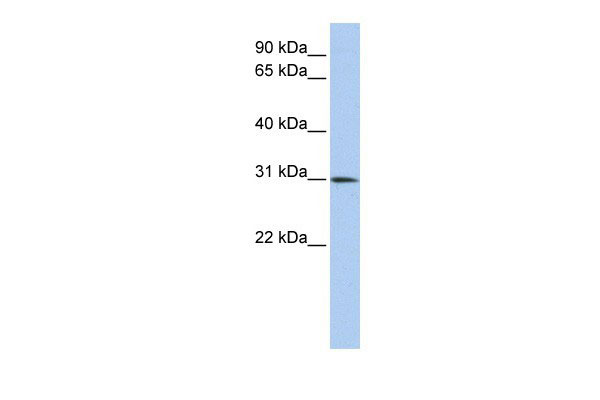DLX1 antibody - C-terminal region
Rabbit Polyclonal Antibody
- SPECIFICATION
- CITATIONS
- PROTOCOLS
- BACKGROUND

Application
| WB |
|---|---|
| Primary Accession | P56177 |
| Other Accession | P56177, NP_835221, NM_178120 |
| Reactivity | Human, Mouse, Rat, Rabbit, Pig, Dog, Guinea Pig, Horse, Bovine |
| Predicted | Human, Mouse, Rat, Chicken, Dog, Guinea Pig, Bovine |
| Host | Rabbit |
| Clonality | Polyclonal |
| Calculated MW | 27 kDa |
| Gene ID | 1745 |
|---|---|
| Other Names | Homeobox protein DLX-1, DLX1 |
| Target/Specificity | DLX1 is a member of a homeobox transcription factor family. It is localized to the nucleus where it may function as a transcriptional regulator of signals from multiple TGF-{beta} superfamily members. DLX1 may play a role in the control of craniofacial patterning and the differentiation and survival of inhibitory neurons in the forebrain.This gene encodes a member of a homeobox transcription factor gene family similiar to the Drosophila distal-less gene. The encoded protein is localized to the nucleus where it may function as a transcriptional regulator of signals from multiple TGF-{beta} superfamily members. The encoded protein may play a role in the control of craniofacial patterning and the differentiation and survival of inhibitory neurons in the forebrain. This gene is located in a tail-to-tail configuration with another member of the family on the long arm of chromosome 2. Alternatively spliced transcript variants encoding different isoforms have been described. |
| Format | Liquid. Purified antibody supplied in 1x PBS buffer with 0.09% (w/v) sodium azide and 2% sucrose. |
| Reconstitution & Storage | Add 50 ul of distilled water. Final anti-DLX1 antibody concentration is 1 mg/ml in PBS buffer with 2% sucrose. For longer periods of storage, store at -20°C. Avoid repeat freeze-thaw cycles. |
| Precautions | DLX1 antibody - C-terminal region is for research use only and not for use in diagnostic or therapeutic procedures. |
| Name | DLX1 |
|---|---|
| Function | Plays a role as a transcriptional activator or repressor (PubMed:14671321). Inhibits several cytokine signaling pathways, such as TGFB1, activin-A/INHBA and BMP4 by interfering with the transcriptional stimulatory activity of transcription factors, such as MSX2, FAST2, SMAD2 and SMAD3 during hematopoietic cell differentiation (PubMed:14671321). Plays a role in terminal differentiation of interneurons, such as amacrine and bipolar cells in the developing retina (By similarity). Likely to play a regulatory role in the development of the ventral forebrain (By similarity). May play a role in craniofacial patterning and morphogenesis and may be involved in the early development of diencephalic subdivisions (By similarity). |
| Cellular Location | Nucleus. |
| Tissue Location | Expressed in hematopoietic cell lines. |

Thousands of laboratories across the world have published research that depended on the performance of antibodies from Abcepta to advance their research. Check out links to articles that cite our products in major peer-reviewed journals, organized by research category.
info@abcepta.com, and receive a free "I Love Antibodies" mug.
Provided below are standard protocols that you may find useful for product applications.
Background
This is a rabbit polyclonal antibody against DLX1. It was validated on Western Blot using a cell lysate as a positive control. Abgent strives to provide antibodies covering each member of a whole protein family of your interest. We also use our best efforts to provide you antibodies recognize various epitopes of a target protein. For availability of antibody needed for your experiment, please inquire (sales@abgent.com).
If you have used an Abcepta product and would like to share how it has performed, please click on the "Submit Review" button and provide the requested information. Our staff will examine and post your review and contact you if needed.
If you have any additional inquiries please email technical services at tech@abcepta.com.













 Foundational characteristics of cancer include proliferation, angiogenesis, migration, evasion of apoptosis, and cellular immortality. Find key markers for these cellular processes and antibodies to detect them.
Foundational characteristics of cancer include proliferation, angiogenesis, migration, evasion of apoptosis, and cellular immortality. Find key markers for these cellular processes and antibodies to detect them. The SUMOplot™ Analysis Program predicts and scores sumoylation sites in your protein. SUMOylation is a post-translational modification involved in various cellular processes, such as nuclear-cytosolic transport, transcriptional regulation, apoptosis, protein stability, response to stress, and progression through the cell cycle.
The SUMOplot™ Analysis Program predicts and scores sumoylation sites in your protein. SUMOylation is a post-translational modification involved in various cellular processes, such as nuclear-cytosolic transport, transcriptional regulation, apoptosis, protein stability, response to stress, and progression through the cell cycle. The Autophagy Receptor Motif Plotter predicts and scores autophagy receptor binding sites in your protein. Identifying proteins connected to this pathway is critical to understanding the role of autophagy in physiological as well as pathological processes such as development, differentiation, neurodegenerative diseases, stress, infection, and cancer.
The Autophagy Receptor Motif Plotter predicts and scores autophagy receptor binding sites in your protein. Identifying proteins connected to this pathway is critical to understanding the role of autophagy in physiological as well as pathological processes such as development, differentiation, neurodegenerative diseases, stress, infection, and cancer.


